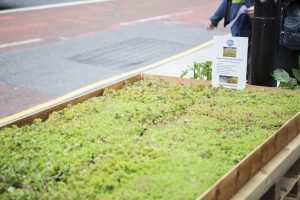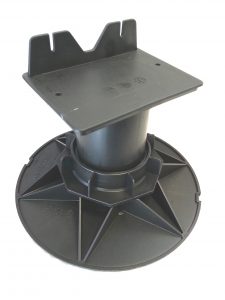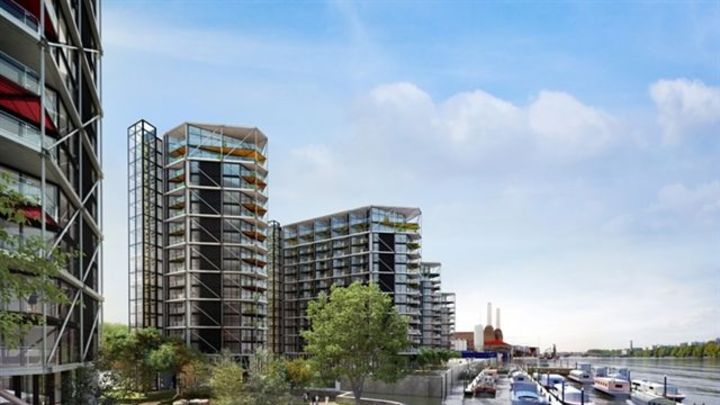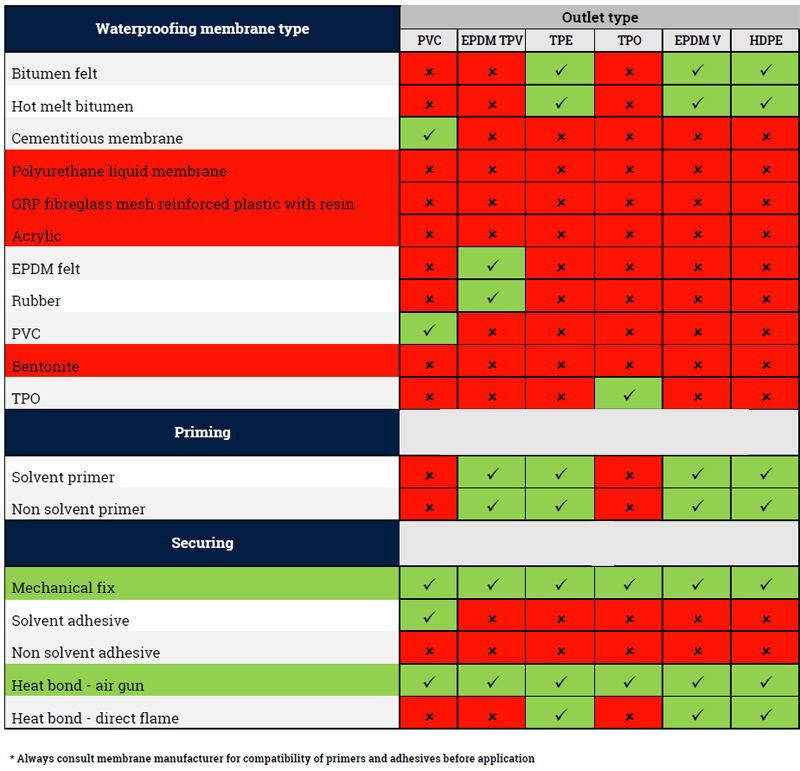Click here www.wallbarn.com/products/roof-and-terrace-finishes/wallbarn-7mm-rubber-pads-paving-decking/ for full details of the new product.
TD PLUS pedestals are coming soon……..
TD PLUS pedestals are coming soon…….
……..with the benefit of fixings at the side of the headpiece on the timber decking supports, installers can fix the joist battens to the units, creating a more secure, sturdy timber decking system.
Wallbarn is working at Riverlight in Vauxhall
Wallbarn is supplying a range of products and services on the prestigious Riverlight project in Vauxhall. The designers and contractors obviously recognize quality when they see it.
Green Roof Guidance
Our friends over at https://www.buildingproducts.co.uk/ recently took an in-depth look into the growth of the green roof industry along with providing a little insight into the possible future for this highly beneficial industry.
Whilst the past 15 years has seen a steady increase throughout the green roofing industry, a lack of specific central government funding or incentives, has resulted in national progress not being maximised.
However, some forward thinking local authorities have played a key role in helping to move the concept of green roofs into mainstream consideration for use in conjunction with urban projects due to the ability of established green roofs to offer an effective solution to main of the common problems associated with urban living, including storm water run-off, air pollution, the ‘heat island’ effect and loss of outdoor space.
Expected Growth
The article then turned its attention to the expected growth of the industry – “Green roofs have long been in use across Europe and the UK, but are still relatively new to many clients, specifiers and contractors. However, living roofs and walls will play a key role in helping to achieve the Mayor’s target to increase green cover in central London by 5% before 2030, with many other major UK cities expected to follow suit.”
“The Greater London Authority’s Green Roof Map estimates that there are already 7000 green roofs in central London alone”
“With space at a premium in cities, vegetated roofs, terraces and gardens are an important means of improving the environment and quality of life for London’s 13 million inhabitants. However, green roofs are far more than just a natural combatant to climate change. With millions of pounds spent on every central London development, they provide an excellent opportunity for the introduction of additional amenity spaces in spatially restricted sites.”
“Intensive roofs such as these have become an increasingly popular option, with biodiverse roofs and wildflowers used to create much needed habitats for bees, butterflies, birds and insects in condensed urban locations. These allow greater scope to create and grow more complex gardens with diverse vegetation and also require specialist green roof designers and installers to deliver them to a high standard.“
Green Roofing Best Practices
The Green Roof Organisation (GRO) Code of Best Practice has been in place since 2011 and is now widely used across the industry. However, an increase in both the number of green roof specifications and their complexity has seen the industry demand a more clear and concise Code for specifiers and installers.
Under the revised guidance, the primary waterproofing layer has also been highlighted as fundamental to the performance of the roof as a whole. Additional guidance has been included for substrate installations, detailing the size of sacks required for certain projects and their subsequent disposal.
For more information on the best practices and the article in full, please check out the Building Products article by clicking here.
Exciting Project
New Zealand’s first six-star green rated building, the Geyser building takes its inspiration from the country’s thermally active geography and is built on sustainable design principles with a very original blend of horticultural innovation and aesthetics.
Designed for Samson Corporation in Auckland’s Parnell, each of the sub-buildings is wrapped in a dynamic, semi-reflective white twin walled facade, which opens and closes in order to moderate the tenants’ thermal environment.
For more on this spectacular development, please click here.
4th International Green Roof Congress
Our friends over at http//www.greenroofs.com regularly take a close look at many of the amazing projects which come to life throughout the world and have just announced that the 4th International Green Roof Congress will be taking place in Istanbal, Turkey in early 2015.
“Explore Nature on Rooftops”
Under the motto “Explore nature on rooftops,” successful solutions and practical green roof technology will be presented, discussed and taught at the upcoming 4th International Green Roof Congress in Istanbul on 20-21 April, 2015. The latest achievements in science and technology will also be presented.
The congress, supported by the International Green Roof Association (IGRA), will be held at the Zorlu Center’s new Raffles Hotel in Istanbul, Turkey.
Urban Transformation
Istanbul has been experiencing a rapid increase in population due to migration. This means a very fast urban transformation process is taking place in the Mediterranean metropolis straddling two continents. One of the main challenges of Istanbul’s green policy is increasing the number of green areas within the whole city.
Desired economic growth and rising land prices on the one hand, and the need for green infrastructure for urban quality of living and sustainable urban development on the other hand, have drawn attention to the city’s rooftops.
Investors have long since recognized that rooftop multi-use not only increases the value of a building, but also improves its attractiveness for leasing. Because no additional land costs are involved, roof gardens are no more expensive than ground level gardens.
For More Information
For more information regarding this exciting event, please take a moment to visit – https://www.greenroofworld.com/
Recycled Geotextile Membranes – All You Need To Know
Wallbarn supply a large recycled geotextile membrane range in a number of different densities & materials. This geotextile fabric range is absolutely ideal for a many different uses, including protection, drainage, filtration, soil stabilisation & green roofing.
Wallbarn’s range of geoxtextile fabrics includes a fabric in the form of a sustainable material called recycled geotextile membrane.
What Is a Recycled Geoxtextile Membrane?
These geotextiles are available as a white material and a multicoloured fabric. The white fabric is slightly stronger than the multicoloured fabric.
Both fabrics have a lower tensile strength than virgin materials, but this reflects the fact that they are recycled existing fibres. They represent significant cost savings and as they are recycled materials they help with sustainability criteria including BREEAM ratings, for example.
Our recycled geotextile membrane range has proven to be extremely popular with the designers and applicators of sustainable construction projects particularly within green roof and bio-diverse roof systems in conjunction with our other sustainable products on offer.
What Applications are Recycled Geoxtextile Membranes Suited For?
Our recycled geotextile membrane range is supplied packed into tight rolls and we can supply material in a variety of roll sizes, from 1 metre wide up to 6 metres wide for very large-scale projects.
These super-jumbo rolls make installation much faster and easier as there will be less individual rolls to sew or seal together – ideal for applications such as landfills.
Geotextile products also have a wide range of use in conjunction with civil engineering solutions. These can be:
- a geotextile filter-fabric in road construction
- geotextiles prevent drainage systems from clogging with fine particles
- erosion control with geotextiles
- geotextiles are used as soil reinforcement agents & as a filter medium in road construction
Recycled polyester geotextile fabrics are particularly well suited for use with horticultural solutions. Some of these uses are:
- prevention of weed growth with geotextiles: ‘a weed control fabric’, often by placing a geotextile layer on top of bare soil & then covering it with a mulch
- moisture conservation with geotextiles, again by placing the geotextile above the soil & applying a mulch above
- a filter layer (e.g. beneath a vegetated roof)
- a weed control layer (e.g. beneath a gravel path)
Further Information
If you would like any more information regarding our recycled polyester geotextile membrane range, please don’t hesitate to contact us through our Facebook page and we’ll be happy to help.
Green Roofing Benefits
Green roofing systems such as the one included in the video above can be a cost-effective way to keep water from running into sewer systems and causing overflows, Columbia University researchers have found.
Rainfall Retention
The Con Edison Green Roof, which is home to 21,000 plants on a quarter acre of The Learning Center, retains 30 percent of the rainwater that falls on it. The plants 
Keeping Water Away From Drainage Systems
If New York City’s 1 billion square feet of roofs were transformed into green roofs, it would be possible to keep more than 10 billion gallons of water a year out of the city sewer system, according to the study led by Stuart Gaffin, research scientist at Columbia’s Center for Climate Systems Research.
The study concluded that based on the cost of building and maintaining a green roof it costs as little as 2 cents a year to capture each gallon of water.
For more on this study please visit https://www.environmentalleader.com/2011/05/09/green-roofs-have-positive-effect-on-sewar-systems/#ixzz3DTEwAmDP
For more on Wallbarn’s green roofing systems, please visit – https://www.wallbarn.com/green-roof-new/











